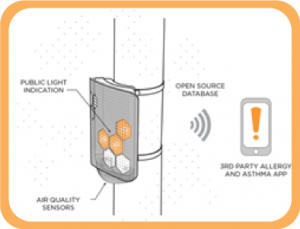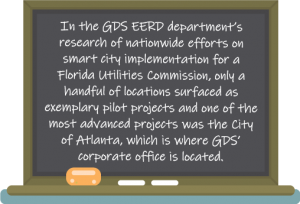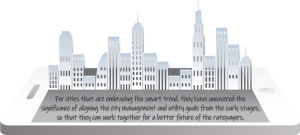- Home
- Services
- Hi-Line Engineering
- About
- Careers
- Contact
- Requests For Proposals
Is Your City Smarter Than A 5th Grader?
by GDS Associates, Inc | June 25, 2019 | News , Newsletter - TransActions
WHAT’S HAPPENING? WHAT IS A SMART CITY?
 Most seasoned business travelers can quickly adjust when arriving in a new city, particularly to the level of available technology commonly used to travel. Whether the convenience is a rideshare service from the airport, traffic and parking data, or public wifi access, there are a flurry of modern conveniences that are expected of some cities. Millions of data points are collected and processed as the business traveler unknowingly walks under and around the equipment that is providing the information.
Most seasoned business travelers can quickly adjust when arriving in a new city, particularly to the level of available technology commonly used to travel. Whether the convenience is a rideshare service from the airport, traffic and parking data, or public wifi access, there are a flurry of modern conveniences that are expected of some cities. Millions of data points are collected and processed as the business traveler unknowingly walks under and around the equipment that is providing the information.
The concept of a “smart city” is not new and has been evolving over time. Regionally, people define the term from their respective perspectives, adding their own innovations based on their own imaginations. In short, a smart city is an integration of physical, digital, and human systems into the infrastructure using virtualization, sensor networks, or vehicle-vehicle communication. So, the definition of a “smart city” is still evolving, particularly in the utility space, and is still very broad. Where it becomes important in the utility consulting or engineering space is when a municipal client says that they want to embrace these technologies, understand grid interactions or the effect on their own energy costs, and have a plan to deal with the onslaught of vendors with a motive to deploy at all costs (or at no cost).
Just as AMI data introduced an endless list of possible uses from a utility planning and implementation point of view, the edge analytics-based capabilities of smart technologies can be so overwhelming that the challenge becomes focusing the noise down to a single goal or set of goals. Using public buildings and areas around them to incorporate more solar, energy storage, and electric vehicle (EV) charging will demonstrate a commitment to the future and utility resilience, so more and more cities and utilities are lining up to explore the space. The downsides are relatively simple and include an increased cyber security vulnerability and general dependence on both the features of the technology and the need for constant power to keep them operating.

To showcase one example of a typical smart city scope, the City of Los Angeles’ Bureau of Street Lighting (BSL) initiated a co-location program to modernize over 220,000 street light poles in the city. The BSL incorporated such technologies as EV charging at the pole base, remote controlled informational nodes, streetlight mounted solar PV, and even fully integrated “smart poles” that combine wireless broadband communication hardware, antennas, radios, and other devices into a seamless and sleek design. This effort will provide multiple benefits to the city such as general traffic congestion easement, additional pole attachment revenue, as well as the primary benefit of helping the city of Los Angeles during catastrophic events such as earthquakes or fires where communication channels can become congested. In these disaster-prone regions, both the upsides and downsides can be amplified during an event, so much care must be taken to provide emergency power or a resilient technology when needed most.
WHAT’S OUT THERE? IS IT WATCHING ME?
 It seems that public safety and convenience are quietly winning the battle over fears of “big brother is watching” in many locations. In the GDS EERD department’s research of nationwide efforts on smart city implementation for a Florida Utilities Commission, only a handful of locations surfaced as exemplary pilot projects and one of the most advanced projects was the City of Atlanta. Unbeknownst to many, the North Avenue corridor, which is located in downtown Atlanta, has been a testing ground for pole -mounted sensors that provide data on pedestrian motion (heat mapping), vehicle crash reduction analytics (near-miss counting), autonomous vehicle interactions (autonomous and emergency vehicle routing), as well as general crowd monitoring through high-definition dome cameras. Many of the cities are also utilizing additional features such as 7 pin pole-mounted gunshot triangulation, 5G antennae deployment, environmental sensors (air and sound), and EV charging.
It seems that public safety and convenience are quietly winning the battle over fears of “big brother is watching” in many locations. In the GDS EERD department’s research of nationwide efforts on smart city implementation for a Florida Utilities Commission, only a handful of locations surfaced as exemplary pilot projects and one of the most advanced projects was the City of Atlanta. Unbeknownst to many, the North Avenue corridor, which is located in downtown Atlanta, has been a testing ground for pole -mounted sensors that provide data on pedestrian motion (heat mapping), vehicle crash reduction analytics (near-miss counting), autonomous vehicle interactions (autonomous and emergency vehicle routing), as well as general crowd monitoring through high-definition dome cameras. Many of the cities are also utilizing additional features such as 7 pin pole-mounted gunshot triangulation, 5G antennae deployment, environmental sensors (air and sound), and EV charging.
 These large aggregations of socio-economic data and behavior patterns are being used to improve public safety and improve efficiency in a host of municipal operations. Of course, all of these conveniences can test the relationship between the city government and the associated utility, even when the general charter between both parties is to beneficially serve the public. Pole attachment fees and electric service revenue sit firmly in the utility interest corner, while pedestrian and crowd analytics are of significant importance to the city government, but all are dependent on the infrastructure in place and the long-term growth plans of both organizations.
These large aggregations of socio-economic data and behavior patterns are being used to improve public safety and improve efficiency in a host of municipal operations. Of course, all of these conveniences can test the relationship between the city government and the associated utility, even when the general charter between both parties is to beneficially serve the public. Pole attachment fees and electric service revenue sit firmly in the utility interest corner, while pedestrian and crowd analytics are of significant importance to the city government, but all are dependent on the infrastructure in place and the long-term growth plans of both organizations.
As this industry has evolved, there has also been an increased role for the federal level decisions that will trickle down to the cities from the FCC, particularly in the arena of 5G technology. The administration has developed a specifically focused group called FAST (Facilitating America’s Superiority in Technology) to help expedite infrastructure readiness for this change to 5G, more info can be found here: https://www.fcc.gov/5G. With the evolution from wide broadcast and larger 4G cellular antennae to the more locally based (and higher quantity) like 5G small cell antennae in the cities, there is an immediate need to have it on the radar of all city planning departments. Smart city technology holds a unique answer to the infrastructure dilemma of where to put the multitude of 5G antennae as the product offerings from technology vendors grow beyond just 5G integrated streetlight poles.
For now, the industry is still encouraging more pilots. Further work will need to be done to align city leadership departments with their utility counterparts on the smart city efforts. This type of alignment is not a new concept, but the treatment of this type of data is still evolving and rarely will the priorities sync. This is just one way to look at a smart city effort, the bigger picture is obviously more relative to where the city is for its baseline.
HOW DO WE DEAL WITH IT (THE TOO MUCH DATA PART)?
he pure range of datapoints available, in combination with cheap cloud storage and edge analytics, has made information discernment a full-time job for many metropolitan areas and IT staff are becoming increasingly important. Compliance with multiple data security policies and FCC ordinances can keep many smaller cities from investing in the full capabilities of a comprehensive system, but the right guidance, with the process can be fairly simple. Most of the sensitive information passed through police or city IT departments is exclusively handled by those departments and most of the vendors have geared their products to cater to this approach. Alternatively, there are efforts by some cities to make the data very available for the benefit of public knowledge, as is the case with the Argonne Array of Things environmental sensor and its publication of data for public consumption, found at https://arrayofthings.github.io/.
CONCLUSIONS
 The quantity and quality of data that is available from the smart technologies will drive the market forward at the executive level, it is just too valuable. Future generations that are going to manage the utilities of the future will have a higher expectation of available data, captured only by the range of technologies in these categories. For cities that are embracing the smart trend, they have uncovered the significance of aligning the city management and utility goals in the early stages so that they can work together for a better future of its citizens/retail ratepayers. It is imperative that the conversations happen early and often so that consultants, city staff, and utilities can set expectations. This will allow the city to move through a valuable pilot process and gather realistic information on the benefits of incorporating smart technologies.
The quantity and quality of data that is available from the smart technologies will drive the market forward at the executive level, it is just too valuable. Future generations that are going to manage the utilities of the future will have a higher expectation of available data, captured only by the range of technologies in these categories. For cities that are embracing the smart trend, they have uncovered the significance of aligning the city management and utility goals in the early stages so that they can work together for a better future of its citizens/retail ratepayers. It is imperative that the conversations happen early and often so that consultants, city staff, and utilities can set expectations. This will allow the city to move through a valuable pilot process and gather realistic information on the benefits of incorporating smart technologies.
For more information or to comment on this article, please contact:
 Josh Duckwall, Project Manager | CONTACT
Josh Duckwall, Project Manager | CONTACT
GDS Associates, Inc. – Marietta, GA
770.799.2437
Download PDF
Also in this issue: FERC ROE Policy In A Flux: What’s Happening & Why It Matters
GET OUR NEWSLETTER
RECENT POSTS
- Why MOD-026-2 Matters: Raising the Bar for Generator and IBR Modeling Reliability
- Exploring the 2026-2028 Reliability Standards Development Plan
- Blackstart Resource Availability During Extreme Cold Weather Conditions
- DOE Pushes FERC to Accelerate Large Load Grid Access
- Building a Cyber-Aware Workforce in the Utility Sector
Archives
- December 2015 (8)
- June 2025 (7)
- January 2016 (6)
- July 2016 (6)
- March 2021 (6)
- May 2022 (6)
- August 2020 (5)
- March 2015 (4)
- January 2019 (4)
- June 2019 (4)
- August 2019 (4)
- February 2020 (4)
- May 2020 (4)
- June 2020 (4)
- December 2020 (4)
- July 2021 (4)
- October 2021 (4)
- April 2024 (4)
- December 2024 (4)
- May 2025 (4)
- April 2015 (3)
- August 2016 (3)
- February 2017 (3)
- July 2017 (3)
- February 2018 (3)
- February 2019 (3)
- November 2019 (3)
- March 2020 (3)
- April 2020 (3)
- September 2021 (3)
- December 2021 (3)
- August 2022 (3)
- December 2022 (3)
- April 2023 (3)
- July 2023 (3)
- December 2023 (3)
- September 2024 (3)
- October 2025 (3)
- December 2025 (3)
- May 2014 (2)
- February 2016 (2)
- March 2016 (2)
- September 2016 (2)
- November 2016 (2)
- January 2017 (2)
- July 2018 (2)
- November 2018 (2)
- March 2019 (2)
- May 2019 (2)
- July 2020 (2)
- September 2020 (2)
- April 2021 (2)
- August 2021 (2)
- October 2024 (2)
- September 2025 (2)
- February 2014 (1)
- April 2014 (1)
- July 2014 (1)
- August 2014 (1)
- November 2014 (1)
- February 2015 (1)
- May 2015 (1)
- June 2015 (1)
- November 2015 (1)
- October 2016 (1)
- December 2016 (1)
- October 2018 (1)
- December 2018 (1)
- April 2019 (1)
- July 2019 (1)
- September 2019 (1)
- October 2020 (1)
- November 2020 (1)
- February 2021 (1)
- April 2022 (1)
- July 2022 (1)
- October 2022 (1)
- August 2023 (1)
- October 2023 (1)
- July 2025 (1)
- November 2025 (1)
Categories
- Newsletter - TransActions (85)
- News (78)
- Employee Spotlight (35)
- Energy Use & Efficiency (28)
- Energy, Reliability, and Security (17)
- Other Specialized Services (11)
- Environment & Safety (10)
- Power Supply (8)
- Transmission (8)
- NERC (7)
- Utility Rates (7)
- Cyber Security (5)
- Energy Supply (4)
- Hi-Line: Utility Distribution Services (4)
- Battery Energy Storage (3)
- Uncategorized (2)
- Agriculture (1)
- Hi-Line: Seminars & Testing (1)